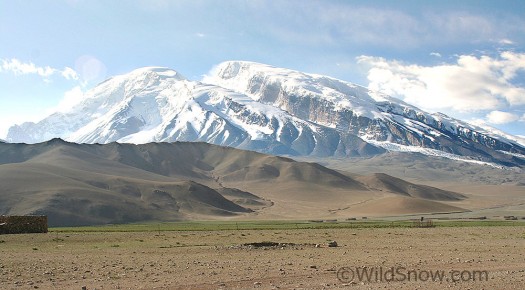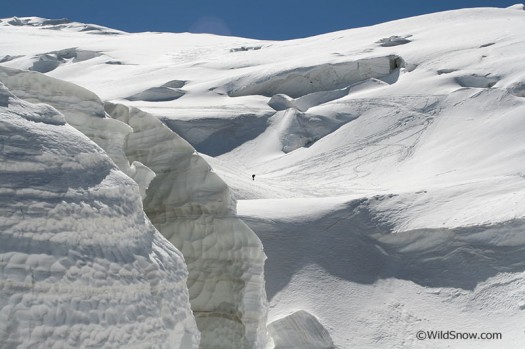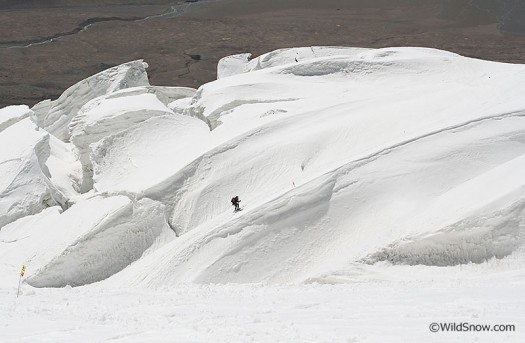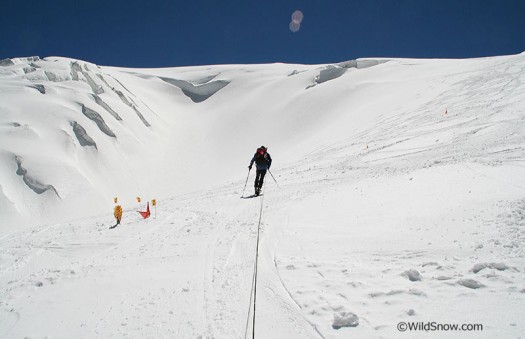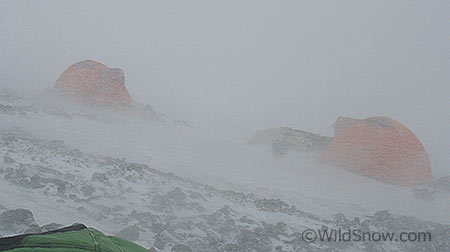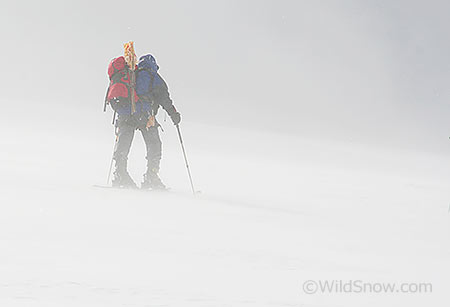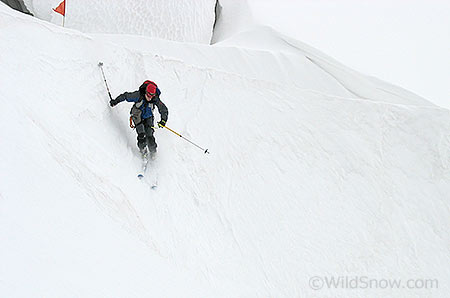(Editor’s note: This trip report was published back when WildSnow was an infant. But Mustagh Ata is always a top goal for adventure skiing, so this story of a group of friends getting challenged deserves conversion to a real blog post! We continue to pull such legacy posts out of our archives, this one from 2006. After reading I want to go, but perhaps with two GPS units.)
At about 24,000 feet, Mustagh Ata in China offered everything we were looking for in an adventure ski trip. Sometimes called the “easiest 7000 meter peak,” Mustagh Ata earns its reputation because you skin up most of its 20-30 degree slopes. But as many people do after finding out how technically easy the climb is, we totally underestimated this peak. Our oversized ski mountaineering egos were severely beaten into submission with our first views of the monolith, and the challenge didn’t stop there. From the drop off at the Karakoram Highway at its base, the nearly 13,000 vertical foot rise starts immediately. Mustagh Ata is huge. Sure, you can skin climb it, but that doesn’t make it any smaller, or close up the crevasses, or improve the weather.
Partners on this trip were Jon Gibans, John Callahan, Jeramie Oates, and my brother Steve. The idea was to climb and ski Mustagh Ata as a trainer for next spring’s planned Cho Oyu and Everest attempts.
We climbed to base camp and finally to snow line at camp 1, in a steep hike all above 14,000 feet. Normally not a big deal, but with our pressed timeline, we were attempting to cram a normal 24 day trip into 12 days. We found ourselves eliminating normal resting-acclimation days to work the mountain. We did this for a couple of reasons. First, this was a training camp for bigger days to come and we wanted to push ourselves to learn more about what we can get away with at these extreme altitudes. Second, the added pressures of family and work didn’t allow for the days of yesteryear where a month or two out in the hills was acceptable. I call it “minimizing the time out to avoid divorce.” In any event, we were eager to see if we could do it and to figure out just how uncomfortable it would actually be. Fortunately for the team, things proved to be acceptable and the years of going to these altitudes climbing and skiing compensated for our unusually quick ascent.
On the fourth day of climbing we got our first taste of the skiing. This included the main obstacle of the climb (other than altitude and weather), a major ice fall encompassing about 2500 feet of the terrain between camp 1 and 2. While we were there, no less than 4 climbers had fallen into crevasses in this section; none thankfully were killed, but one guide found himself 60 feet below the surface of the glacier for 3 hours before his clients could get to another guide to retrieve a rope. Our skis made this terrain much safer than the standard snowshoes, however, we roped up for the ascent anyway. As we climbed, we carefully scoped out the lines that we could then ski without the hindrance.
The weather had proven to be stormy for much of the trip, making for miserable climbing and camp building. But this also provided us with about 6 inches of fresh powder for our first turns from just over 20,000 feet. It was amazing how the skiing turned the discomfort of quick altitude and stormy conditions into the perfect day! The smooth slopes just above the ice fall lead to the near vertical slopes of the ice walls encompassed in the debris of the glacier falling towards camp 1. The skiing was steep and exposed to the nooks and crannies of the black holes into hundreds of feet of mangled ice. We carefully chose our lines through the mayhem until we were again on smooth slopes leading to the route below. The skiing was super!
Over the next few days we established our second camp at 20,000 feet. The skiing remained excellent and a bonus to the difficult load hauling at altitude. In the process, we also decided that we would avoid a third camp used by most teams as a high camp. Over the years we have proven to ourselves that the necessary effort to carry an entire camp to normal high camps is more difficult than creating a long summit day. On Shishpangma in 2000, deteriorating weather forced us into a position where we did not have a choice; we managed to climb almost 4500 vertical to the Central Summit at 8027 meters with the skis, and forever in our minds proved that we could accomplish long summit pushes. But no matter, altitude above 7000 meters is intimidating, and despite our track record, mentally, the more than 4000 foot push left questions in our minds and sleepless nights of anticipation. Added to this was that our time on the mountain thus far was so limited that we were not fully acclimated.
We headed off on our summit push on our 10th day on the mountain, a day earlier than expected due to a French weather report suggesting that a storm was moving into the area. This was far from desirable as the team was extremely tired and desperately needed every minute of additional acclimatization possible; but in the mountains, you climb when they let you, not necessarily when you want to. So with heavy legs, we relied on summit fever for motivation.
The weather deteriorated more, and by the evening of the 11th day, we found ourselves at our high camp with wind and whiteout conditions (and our tails between our legs). At over 20,000 feet with the prospects of wind and cold for the big day, sleep came with difficulty. Mustagh Ata is a broad monolith of a mountain where winds and white-out conditions have claimed a handful of would-be summiteers. We had read reports of a team the previous season heading to the summit in such conditions, never to be seen again. The real estate up there is huge, and without direction, it is extremely easy to simply get lost, walk off one of the two vertical walls bordering the route, or fall into any of the thousands of hidden crevasses. Even with a GPS and wands, the prospects of navigation on Mustagh Ata under such conditions is extremely difficult. And if the winds kick in to high gear, a human will not stand a chance; there is no shelter on the featureless glacier slopes. As such, our desire was mixed with common sense and experience enough to know that our bid was very much in question.
We woke up at 3:30 to brew up and get going as early as possible. Our three Nemo tents were pitched side by side, and as the Primus stoves purred, we discussed the day. Our timeline gave us one shot for the summit, so it was now or never. JO and Gibjo had been to camp 3 a couple of days earlier, and they felt that the route was doable even in the marginal conditions. It was also discussed that we wanted to go for at least 7,000 meters to notch another 7,000 meter (23,200 feet) ski descent; JO and Callahan each had one from our previous Everest attempt in 2000, while Steve and I would be going for our third after the same Everest attempt as well as our ski of Shishpangma’s central summit. So we proceeded to rope up, and head into the storm.
A previous Swiss team had placed wands on route which really aided us despite also using Callahan’s GPS. In a few hours, we reached camp 3 where another team was abandoning the mountain for base camp, the conditions proving to be too much for them. We were now at about 22,000 feet, and still a little more than a thousand feet from 7,000 meters. We borrowed a handful of additional wands to supplement the Swiss effort as the conditions made finding their path very difficult and we continued on. The going was slow, but the winds had abated a bit and the traveling between wands doable. We were actually greeted by sucker holes in the cloud cover which lifted our hopes that maybe the system would clear out. But as quickly as the holes would appear, they would dissolve into the gray abyss outlined only by our wands. We proceeded with great care.
Soon we found ourselves at the 7,000 meter mark with the wands continuing us onward. We climbed on to around 24,000 feet to a point where the glacier leveled off onto the summit plateau. As forewarned by the Swiss, the wands ran out. Being in the lead, at this point, I wandered to a stop only to lean on my poles to search for the next wand. At the crest, I failed to see a large crevasse only 3 feet in front of my nose; as one ski fell away beneath me, I caught my self to avoid the fall. This was not a huge deal, but it reinforced the severity of our situation and the fine line separating a good day from a bad day, and possibly explained how a team could just disappear in such conditions.
Despite the almost flat walk to the summit, we had no idea which way to go to get there, and we were having a difficult time with the objective dangers that we knew were out there even though we could not see them. But so far, the day proved to be, at least physically, a gentle and easy skin into the sky despite our earlier concerns to the contrary, and we were eager to continue if at all possible. We waited at this point for almost an hour in hopes that the clouds would lift and the views would send us on our way. It was wishful thinking. The wind gradually picked up, and it became clear that we only had one choice; we needed to descend back towards the wands and to the safety of our camp some 4,000 feet below. The markers were the only reference that deciphered not only the direction to ski, but also the pitch hidden in the complete vertigo from the conditions. Our tracks were buried from the wind and new snow, and we skied slowly between the flags to avoid any possible hidden crevasses. It was survival skiing at its best despite the otherwise great conditions. Finally, just out of camp 3, we could see well enough to enjoy skiing our way back to camp two.
Our bid was complete and despite not reaching the summit, we experienced a super adventure into the clouds. We all managed to ski from above 7,000 meters, the main goal of the trip, and we had the satisfaction of knowing we had given it our best effort. Tired and relieved to be off the mountain, later that night, we toasted with cold beer and smiles on our faces. The excitement and casual talk leading up to our ascent and descent of this the “easiest” 7,000 meter peak had been humbled back to the reality of life in the Himalaya and we realized that the term “easiest” is relative.
Mustagh Ata didn’t disappoint us. It is a true Himalayan peak in all respects: high, huge, and from its base overwhelming. Its reputation does not prepare you for the difficulties involved with slogging at extreme high altitude for such long periods. You can skin to the summit but that doesn’t trivialize the climb. After actually ascending the slopes above 7,000 meters did I come to realize how incredible it is that you can ski up this peak; there is no other ski tour even remotely similar to Mustagh Ata. More, Mustagh Ata is the hub of the largest convergence of the world’s great ranges; at this point, you view the convergence of the Hindu Kush, the Karakoram, the Alayskiy, Tian Shan and the Kunlan Shan, and enjoy incredible mountain views reaching Peak Lenin in Kyrgistan, to K2 and Broad peak in the Karakoram. The area’s vastness dwarfs anything we had ever seen, and the savageness of the mountains that stretch for miles beyond what you can see is beyond description. When climbing in the area, you are most definitely on the top of the world.
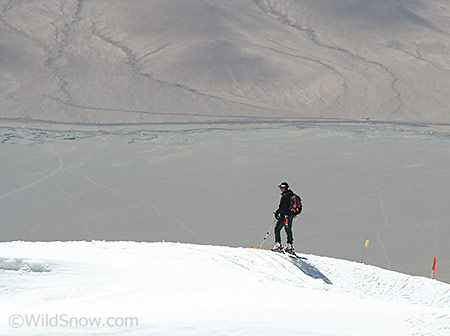
JO scoping out the Karakoram Highway far below.

